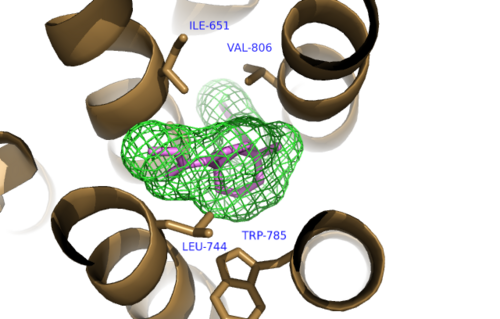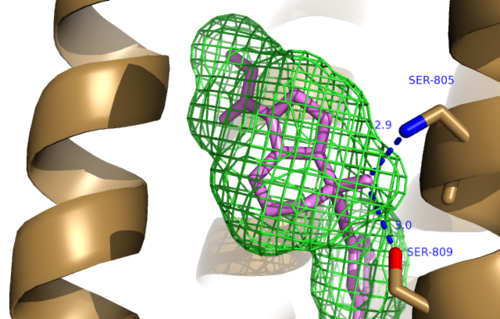User:Daniel Schemenauer/Sandbox 1
From Proteopedia
(Difference between revisions)
| Line 2: | Line 2: | ||
= metabotropic Glutamate Receptor 5 ''Homo sapiens''= | = metabotropic Glutamate Receptor 5 ''Homo sapiens''= | ||
== Introduction == | == Introduction == | ||
| - | G-coupled protein receptors [https://en.wikipedia.org/wiki/G_protein–coupled_receptor GPCR's] are trans-membrane proteins that are integral to cell signaling. The human genome encodes for approximately 750 GPCR's, 350 of which are known to respond to extracellular ligands | + | G-coupled protein receptors [https://en.wikipedia.org/wiki/G_protein–coupled_receptor GPCR's] are trans-membrane proteins that are integral to cell signaling. The human genome encodes for approximately 750 GPCR's, 350 of which are known to respond to extracellular ligands<ref name="GPCRRep">PMID: 12679517 </ref>. GPCR's are divided into four major classes based on sequence similarity and transduction mechanism: Class A,B,C, and F<ref name="MSGPCR">PMID:23407534</ref>. Metabotropic Glutamate Receptor 5 (mGlu<sub>5</sub>) is a class C GPCR that is involved in the G<sub>q</sub> pathway<ref name="CCGPCR">PMID:12782243</ref>. mGlu<sub>5</sub> is highly expressed in neuronal and glial cells in the central nervous system, where glutamate serves as the major neurotransmitter. When glutamate binds to the extracellular domain of mGlu<sub>5</sub> consisting of the Venus Fly Trap motif<ref name="Primary">PMID: 25042998 </ref>, a conformational change through the trans-membrane domains activates the coupled G-protein. This G-protein disassociates and the alpha subunit activates [https://en.wikipedia.org/wiki/Phospholipase_C Phospholipase C] which has the final outcome of increased neuronal activity<ref name="MSGPCR">PMID:23407534</ref>. |
== Structure == | == Structure == | ||
=== Overall Stucture === | === Overall Stucture === | ||
| - | mGlu<sub>5</sub> is seen as a [https://en.wikipedia.org/wiki/Protein_dimer homodimer] ''in vivo,'' with each subunit being comprised of three domains: extracellular, trans-membrane and cysteine-rich. The structures shown here are centered on the trans-membrane domain, comprised of seven α-helices all roughly parallel to one another <ref name="Primary">PMID: 25042998 </ref>. Also displayed is the Intracellular Loop (ICL) 1 which forms a short α-helix. Additionally, ICL3 and Extracellular Loops (ECL) 1 and 3 all lack secondary structure, and ECL2 interacts with trans-membrane (TM) helices 1,2, and 3 as well as ECL 1<ref name="Primary">PMID: 25042998 </ref>. | + | mGlu<sub>5</sub> is seen as a [https://en.wikipedia.org/wiki/Protein_dimer homodimer] ''in vivo,'' with each subunit being comprised of three domains: extracellular, trans-membrane and cysteine-rich. The structures shown here are centered on the trans-membrane domain, comprised of seven α-helices all roughly parallel to one another<ref name="Primary">PMID: 25042998 </ref>. Also displayed is the Intracellular Loop (ICL) 1 which forms a short α-helix. Additionally, ICL3 and Extracellular Loops (ECL) 1 and 3 all lack secondary structure, and ECL2 interacts with trans-membrane (TM) helices 1,2, and 3 as well as ECL 1<ref name="Primary">PMID: 25042998 </ref>. |
===Key Interactions=== | ===Key Interactions=== | ||
A number of intramolecular interactions within the trans-membrane domain stabilize the inactive conformation of mGlu<sub>5</sub>. The first of these interactions is an ionic interaction, termed the <scene name='72/726409/Ionic_lock2/1'>Ionic Lock</scene>, between Lysine 665 of TM3 and Glutamate 770 of TM6. Evidence for the importance of this interaction came through a kinetic study of mutant proteins where both residues were separately mutated to alanine, resulting in constitutive activity of the GPCR and its coupled pathway<ref name="Primary">PMID: 25042998 </ref>. A second critical interaction that stabilizes the inactive conformer is a <scene name='72/726409/Hydrogen_bond_614-668/1'>Hydrogen Bond </scene> between Serine 614 of ICL1 and Arginine 668 of TM3. Similarly, when Serine 614 was mutated to alanine, high levels of activity were seen in the mutant GPCR<ref name="Primary">PMID: 25042998 </ref>. | A number of intramolecular interactions within the trans-membrane domain stabilize the inactive conformation of mGlu<sub>5</sub>. The first of these interactions is an ionic interaction, termed the <scene name='72/726409/Ionic_lock2/1'>Ionic Lock</scene>, between Lysine 665 of TM3 and Glutamate 770 of TM6. Evidence for the importance of this interaction came through a kinetic study of mutant proteins where both residues were separately mutated to alanine, resulting in constitutive activity of the GPCR and its coupled pathway<ref name="Primary">PMID: 25042998 </ref>. A second critical interaction that stabilizes the inactive conformer is a <scene name='72/726409/Hydrogen_bond_614-668/1'>Hydrogen Bond </scene> between Serine 614 of ICL1 and Arginine 668 of TM3. Similarly, when Serine 614 was mutated to alanine, high levels of activity were seen in the mutant GPCR<ref name="Primary">PMID: 25042998 </ref>. | ||
A <scene name='72/726404/Scene_6/3'>Disulfide Bond </scene> between Cysteine 644 of TM3 and Cysteine 733 of ECL2 is critical at anchoring ECL2 and is highly conserved across Class C GPCR’s<ref name="Primary">PMID: 25042998 </ref>. The ECL2 position combined with the helical bundle of the trans-membrane domain creates a <scene name='72/726409/Electrogradient2/3'>Binding Cap</scene> that restricts entrance to the allosteric binding site within the seven trans-membrane α-helices. This restricted entrance has no effect on the natural ligand, glutamate, as it binds to the extracellular domain, but this entrance dictates potential drug targets that act through allosteric modulation<ref name="Primary">PMID: 25042998 </ref>. | A <scene name='72/726404/Scene_6/3'>Disulfide Bond </scene> between Cysteine 644 of TM3 and Cysteine 733 of ECL2 is critical at anchoring ECL2 and is highly conserved across Class C GPCR’s<ref name="Primary">PMID: 25042998 </ref>. The ECL2 position combined with the helical bundle of the trans-membrane domain creates a <scene name='72/726409/Electrogradient2/3'>Binding Cap</scene> that restricts entrance to the allosteric binding site within the seven trans-membrane α-helices. This restricted entrance has no effect on the natural ligand, glutamate, as it binds to the extracellular domain, but this entrance dictates potential drug targets that act through allosteric modulation<ref name="Primary">PMID: 25042998 </ref>. | ||
===Comparison with Class A and B GPCRs=== | ===Comparison with Class A and B GPCRs=== | ||
| - | The structure of the trans-membrane domain of mGlu<sub>5</sub> was compared to rhodopsin, a class A GPCR, and CRF<sub>1</sub>R, a class B GPCR. The superimposition of all three structures demonstrated the greatest divergence occurred across the top half of the trans-membrane bundle, attributing to the different extracellular domains that accompany each GPCR class. Furthermore, mGlu<sub>5</sub> TM7 is shifted inwards 5 Å compared to the class A GPCR, and TM5 is shifted inwards 6 Å compared to both GPCRs, thus narrowing the allosteric binding entrance <ref name="Primary">PMID: 25042998 </ref>. | + | The structure of the trans-membrane domain of mGlu<sub>5</sub> was compared to rhodopsin, a class A GPCR, and CRF<sub>1</sub>R, a class B GPCR. The superimposition of all three structures demonstrated the greatest divergence occurred across the top half of the trans-membrane bundle, attributing to the different extracellular domains that accompany each GPCR class. Furthermore, mGlu<sub>5</sub> TM7 is shifted inwards 5 Å compared to the class A GPCR, and TM5 is shifted inwards 6 Å compared to both GPCRs, thus narrowing the allosteric binding entrance<ref name="Primary">PMID: 25042998 </ref>. |
== Clinical Relevance == | == Clinical Relevance == | ||
===Role in Diseases=== | ===Role in Diseases=== | ||
| - | mGlu<sub>5</sub> is located mainly post-synaptically and is in high abundance in the [https://en.wikipedia.org/wiki/Nucleus_accumbens nucleus accumbens], [https://en.wikipedia.org/wiki/Caudate_nucleus caudate nucleus], [https://en.wikipedia.org/wiki/Striatum striatum], [https://en.wikipedia.org/wiki/Hippocampus hippocampus] and [https://en.wikipedia.org/wiki/Cerebellum cerebellar cortex] <ref name="Local">PMID: 8295733 </ref>.These areas of the brain are highly involved in cognition, motivation, and emotion, which are essential neural functions for everyday life. Diseases and other mental deficiencies arise from either an overactivation of the GPCR, which overactivates its coupled signaling pathway, or from underactivation of both the GPCR and its coupled pathway. Negative allosteric modulators (NAMs) work to decrease protein activity and are being studied as treatments for [https://en.wikipedia.org/wiki/Fragile_X_syndrome fragile X-syndrome], depression, anxiety and [https://en.wikipedia.org/wiki/Dyskinesia dyskinesia]. Conversely, positive allosteric modulators (PAMs) work to increase protein activity and are being studied for the treatment of schizophrenia and cognitive disorders<ref name="Diseases">PMID: 24237242</ref>. | + | mGlu<sub>5</sub> is located mainly post-synaptically and is in high abundance in the [https://en.wikipedia.org/wiki/Nucleus_accumbens nucleus accumbens], [https://en.wikipedia.org/wiki/Caudate_nucleus caudate nucleus], [https://en.wikipedia.org/wiki/Striatum striatum], [https://en.wikipedia.org/wiki/Hippocampus hippocampus] and [https://en.wikipedia.org/wiki/Cerebellum cerebellar cortex]<ref name="Local">PMID: 8295733 </ref>.These areas of the brain are highly involved in cognition, motivation, and emotion, which are essential neural functions for everyday life. Diseases and other mental deficiencies arise from either an overactivation of the GPCR, which overactivates its coupled signaling pathway, or from underactivation of both the GPCR and its coupled pathway. Negative allosteric modulators (NAMs) work to decrease protein activity and are being studied as treatments for [https://en.wikipedia.org/wiki/Fragile_X_syndrome fragile X-syndrome], depression, anxiety and [https://en.wikipedia.org/wiki/Dyskinesia dyskinesia]. Conversely, positive allosteric modulators (PAMs) work to increase protein activity and are being studied for the treatment of schizophrenia and cognitive disorders<ref name="Diseases">PMID: 24237242</ref>. |
===Interactions with a Negative Allosteric Modulator=== | ===Interactions with a Negative Allosteric Modulator=== | ||
Revision as of 13:28, 29 March 2016
| |||||||||||
References
- ↑ Vassilatis DK, Hohmann JG, Zeng H, Li F, Ranchalis JE, Mortrud MT, Brown A, Rodriguez SS, Weller JR, Wright AC, Bergmann JE, Gaitanaris GA. The G protein-coupled receptor repertoires of human and mouse. Proc Natl Acad Sci U S A. 2003 Apr 15;100(8):4903-8. Epub 2003 Apr 4. PMID:12679517 doi:http://dx.doi.org/10.1073/pnas.0230374100
- ↑ 2.0 2.1 Venkatakrishnan AJ, Deupi X, Lebon G, Tate CG, Schertler GF, Babu MM. Molecular signatures of G-protein-coupled receptors. Nature. 2013 Feb 14;494(7436):185-94. doi: 10.1038/nature11896. PMID:23407534 doi:http://dx.doi.org/10.1038/nature11896
- ↑ Pin JP, Galvez T, Prezeau L. Evolution, structure, and activation mechanism of family 3/C G-protein-coupled receptors. Pharmacol Ther. 2003 Jun;98(3):325-54. PMID:12782243
- ↑ 4.0 4.1 4.2 4.3 4.4 4.5 4.6 4.7 4.8 4.9 Dore AS, Okrasa K, Patel JC, Serrano-Vega M, Bennett K, Cooke RM, Errey JC, Jazayeri A, Khan S, Tehan B, Weir M, Wiggin GR, Marshall FH. Structure of class C GPCR metabotropic glutamate receptor 5 transmembrane domain. Nature. 2014 Jul 31;511(7511):557-62. doi: 10.1038/nature13396. Epub 2014 Jul 6. PMID:25042998 doi:http://dx.doi.org/10.1038/nature13396
- ↑ Shigemoto R, Nomura S, Ohishi H, Sugihara H, Nakanishi S, Mizuno N. Immunohistochemical localization of a metabotropic glutamate receptor, mGluR5, in the rat brain. Neurosci Lett. 1993 Nov 26;163(1):53-7. PMID:8295733
- ↑ Li G, Jorgensen M, Campbell BM. Metabotropic glutamate receptor 5-negative allosteric modulators for the treatment of psychiatric and neurological disorders (2009-July 2013). Pharm Pat Anal. 2013 Nov;2(6):767-802. doi: 10.4155/ppa.13.58. PMID:24237242 doi:http://dx.doi.org/10.4155/ppa.13.58


